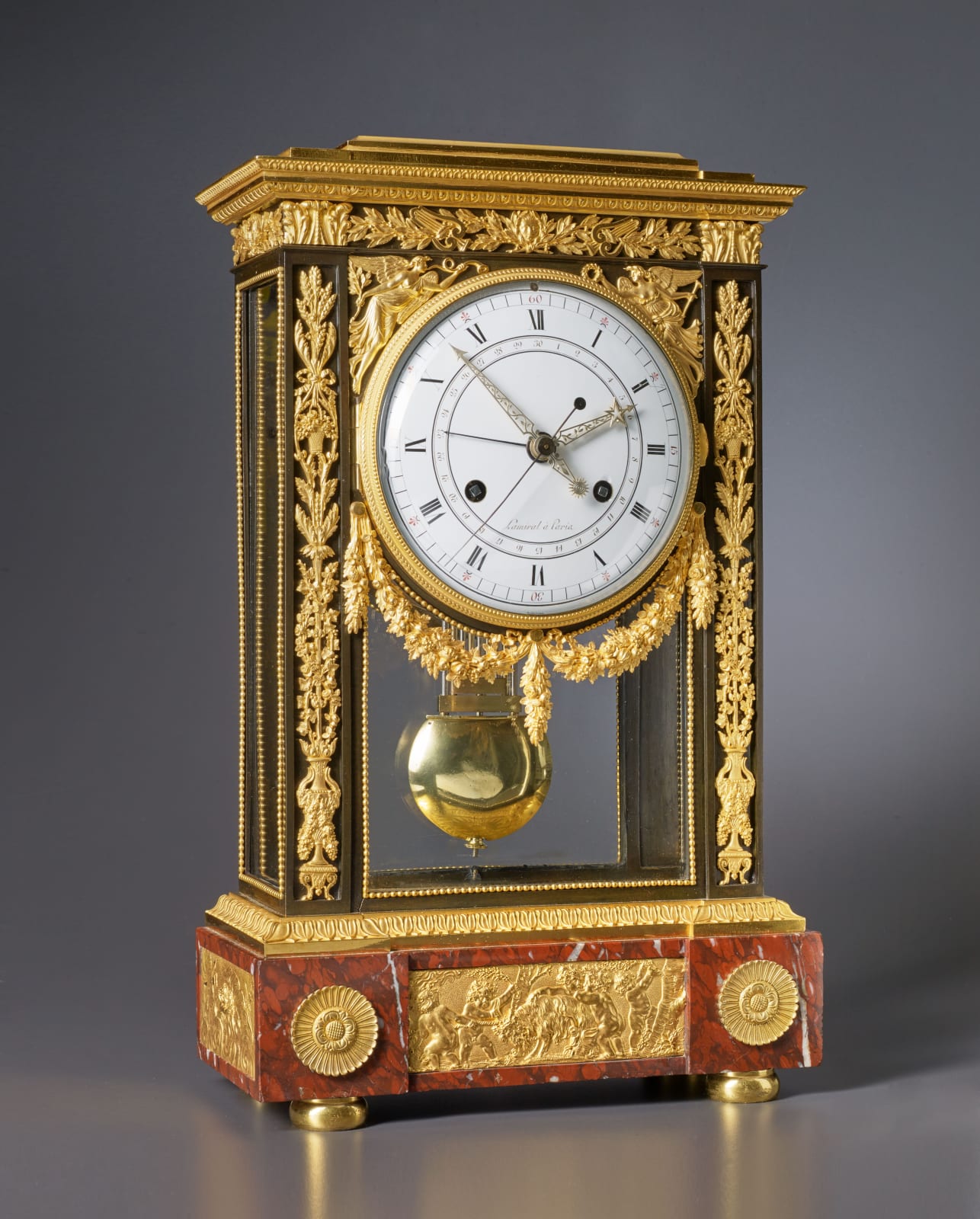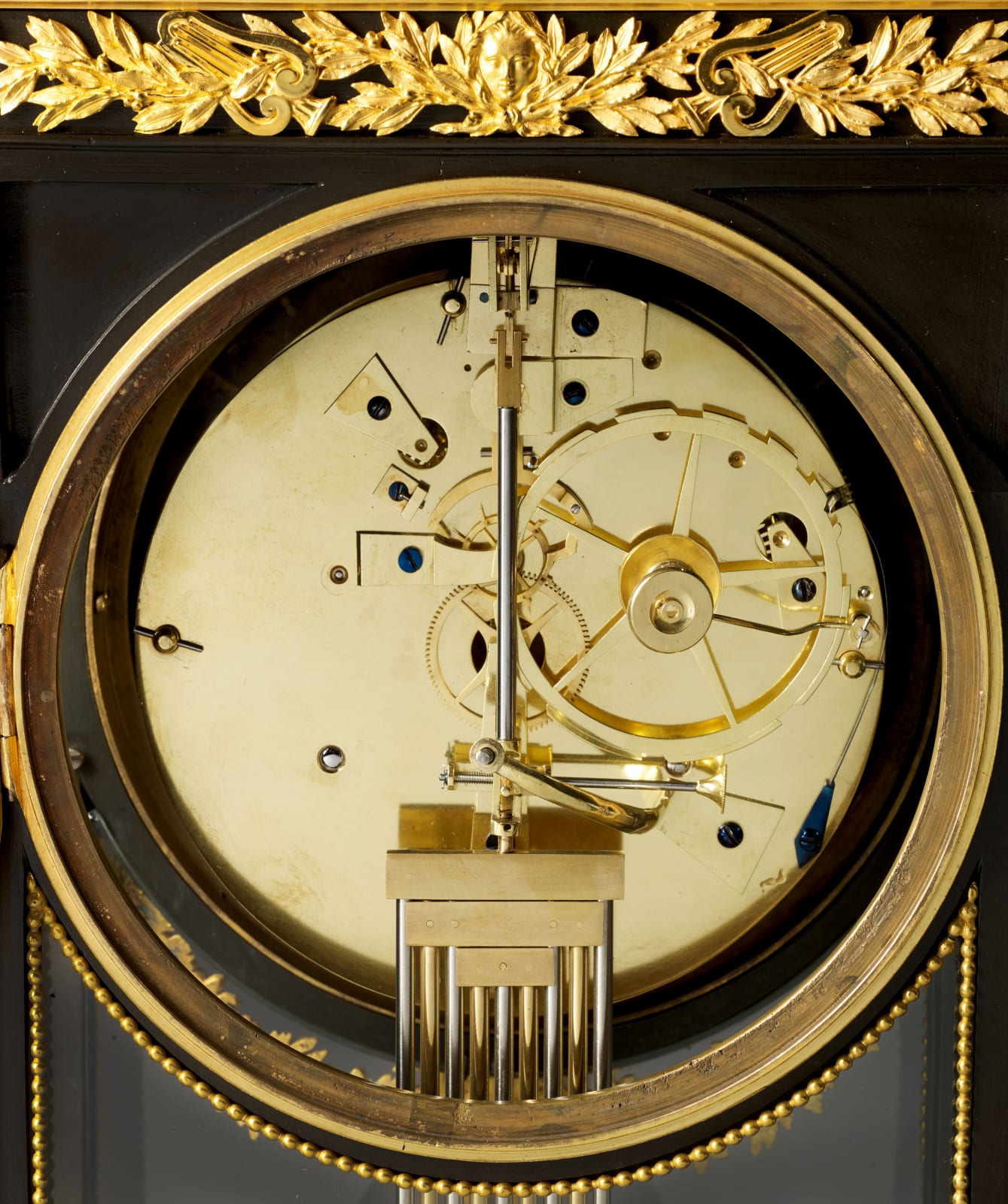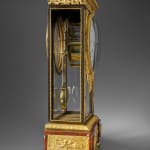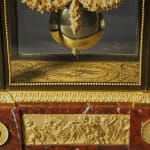Lamiral
Further images
A magnificent Directoire gilt and patinated bronze and rouge griotte marble table regulator of at least two weeks duration by Lamiral à Paris with a superb polychrome painted dial by Etienne Gobin, known as Dubuisson housed in an exceptionally beautiful case attributed to Pierre-Philippe Thomire, signed on the white enamel dial Lamiral à Paria and also Dubuisson below 6 o’clock. The white enamel dial with black Roman hour numerals and outer red Arabic minute numerals marked 15/30/45/60 and red fleurs-de- lis at the intervening five minute intervals, with an inner calendar ring marked with gilt painted numerals for the Republican 30 days of the month, with an extremely fine pair of pierced silvered hands, the hour hand with a star and the minute hand with a sun, also with a pair of blued steel pointers for the calendar indications and for the sweep centre seconds and a winding hole above 12 o’clock for fast/slow regulation. The substantial movement with unusual coup-perdu escapement, spring suspension, striking on the hour and half hour with outside count wheel and a massive nine rod gridiron compensated pendulum above a large brass bob. The magnificent case of rectangular form, the stepped top with egg-and-dart borders above Corinthian capitals flanking a frieze mounted with a central Apollo mask, a pair of harps and foliate sprays, the dial with a beaded bezel mounted in the upper corners by a pair of winged Victory spandrels, the one to the left blowing a horn and carrying a laurel branch and the one to the right holding a wreath in one hand and a horn in the other, the dial decorated below by abundant swags of flowers, fruits and foliage hung from rings and flanked either side by pilasters with inset mounts comprising sheaves of corn, baskets filled with flowers and fruits, interwoven floral and foliate sprays issuing from torchères with rams’ head handles above abundant vine sprays, with an usual and superb gilt bronze plaque below the bob on the inside floor decorated with a sunburst within a ring of florets and surrounding foliate sprays. The shaped rectangular rouge griotte base headed by a gilt bronze stiff leaf border and further mounted with rosettes to either side and a central frieze portraying putti with a ram in a wooded glade, the whole upon bun feet
Paris, date circa 1795
Height 52 cm, width 32 cm, depth 14 cm.
This is a very unusual and possibly unique regulator. Not only are the gilt bronze mounts, the plaque below the pendulum, the polychrome painted dial and also the silvered hands of exceptional quality but the substantial movement is fitted with a rare coup-perdu escapement – a feature that is usually only found on high quality French clocks and regulators. Given all these factors, it can be assumed that this piece was specially commissioned by an important individual and would have been very expensive. Mention has already been made of the exquisite mounts which include a typical Louis XVI frieze on the base as well as slightly later classical mounts above. Given their quality and intricacy, these can be attributed to the renowned fondeur-ciseleur Pierre-Philippe Thomire (1751-1843) whose name is so often associated with the esteemed enamel dial painter Etienne Gobin, known as Dubuisson (b. 1731 d. after 1815).
The substantial movement is as finely executed as the case and dial. In addition to its massive nine rod brass and steel compensated pendulum (which allows for the smallest of temperature variations), it also features a coup-perdu escapement. Coup-perdu literally means ‘lost beat’; such an escapement enables the seconds hand to jump full seconds with a pendulum which beats half seconds. Usually this is achieved by a type of pinwheel escapement which has one pallet hinged to the anchor onto which the pins of the pinwheel drop. When the pendulum swings to the left, the weight at the outer end of the pivoted pallet lifts the coup-perdu pallet clear of the exit pallet which in turn enables the pendulum to receive impulse on its swing to the right. The next pin drops onto the coup-perdu pallet, closing it onto the impulse pallet and thereby continuing the cycle.
Given the quality of the dial, case and movement, it is surprising that so little is known about its maker, namely Lamiral à Paris whose name is associated with Louis XVI, Directoire and Empire clocks and regulators. From 1806-1812 a pendulier of this name was based both at rue de la Vieille Monnaie and rue des Saints-Pères while Lamiral à Paris also worked from Marché St-Jean 1815, rue des Mauvais Garçons 1817-20 and at Grenier St Lazare when listed as a debtor of the bronzier Gérard-Jean Galle (1788-1846). One of Lamiral’s clocks is housed in the Museo de Reloges at Jerez de la Frontera while a Louis XVI astronomical skeleton clock, signed Lamiral à Paris and featuring with a fine enamel frame and dials by Joseph Coteau was previously sold by Richard Redding Antiques.
Interestingly the present regulator has an equally beautiful dial decorated by Dubuisson who with Coteau was the leading enamel painter of his day. Dubuisson was born in Lunéville and worked firstly as a porcelain painter in his hometown as well as in Strasbourg and Chantilly. Like Coteau, he was employed at Sèvres, where from 1756-9 he worked as a flower painter before specializing on his own account by supplying the finest enamelled watchcases and clock dials to the leading clockmakers of his day. In addition to Lamiral, they included Jean-Simon Bourdier, Robert Robin, Louis Berthoud, Dieudonné Kinable, Antide Janvier and Pierre-Basile Lepaute. During the 1790s Dubuisson was recorded in the rue de la Huchette and later in circa 1812 at rue de la Calandre as well as rue des Lavandières Sainte-Opportune. As one of the leaders in his field, Dubuisson won the respect of many. For instance, when Louis Berthoud described one of Dubuisson’s dials showing decimal time, he noted that it “can be regarded as a masterpiece of outstanding craftsmanship” (Jean-Dominique Augarde, “Les Ouvriers du Temps”, 1996, p.103). Likewise, Antide Janvier praised Dubuisson’s set of intricate dials, made for one of his astronomical clocks, noting “The dials are executed by citizen Dubuisson, who unites the greatest dexterity in his art with a knowledge which guarantees the success of the most difficult pieces: it is a real service to collectors to tell them of this modern and hardworking artist”. (ibid, p. 104 and illustrated pp. 106-7). At a later date Janvier also wrote “I liked M. Dubuisson as an artist, before learning to admire him as a good father, good friend and good citizen, He is a worthy man in every respect.” (ibid., p. 104).







